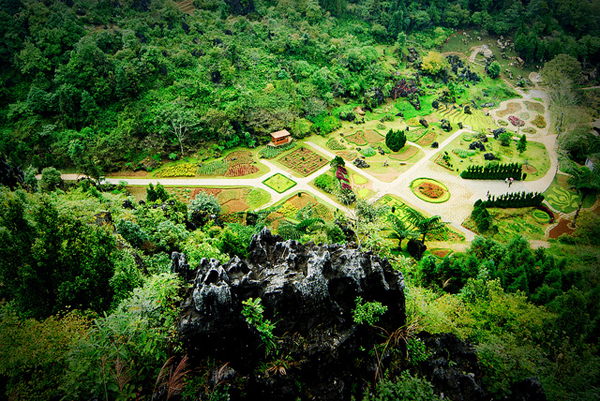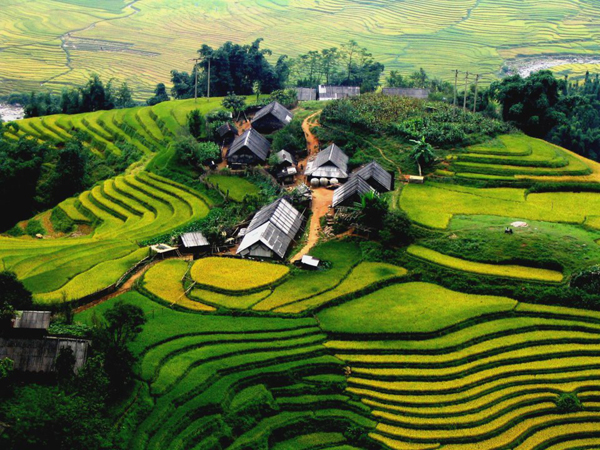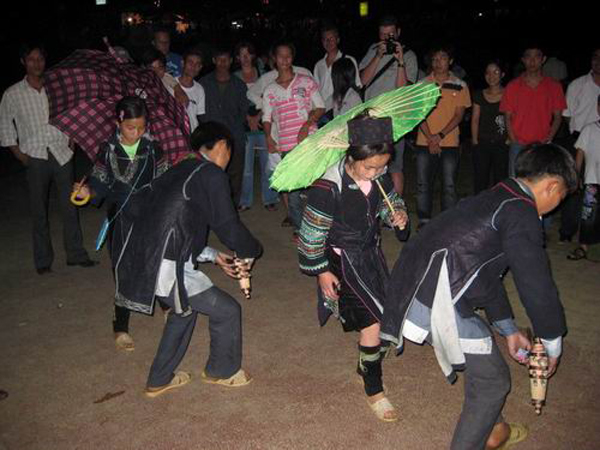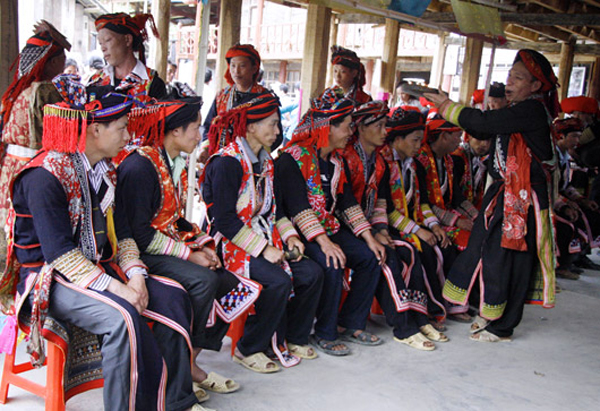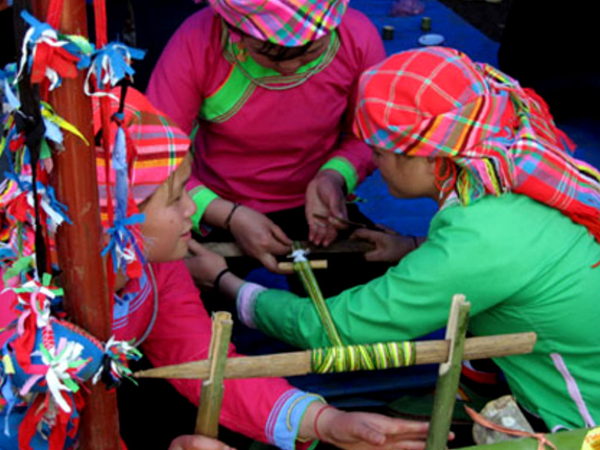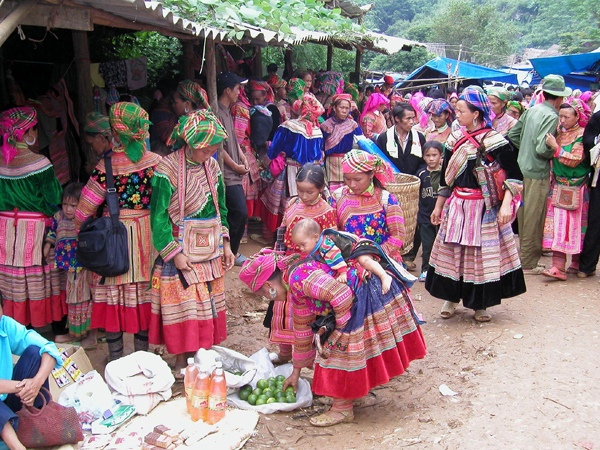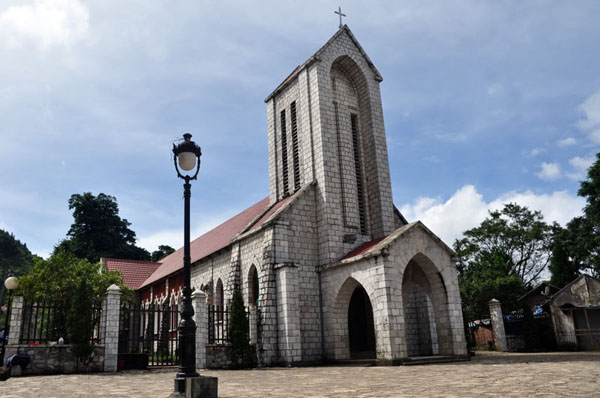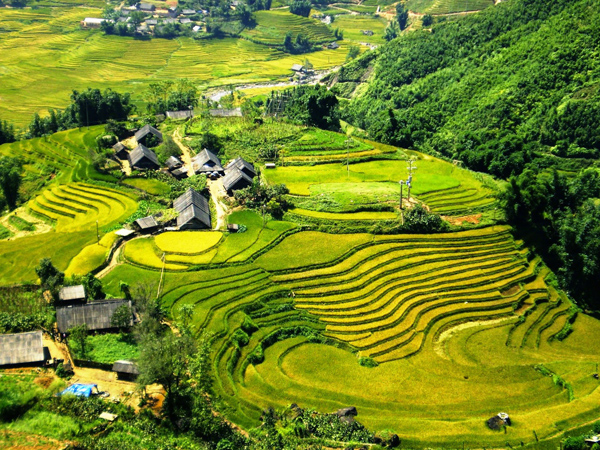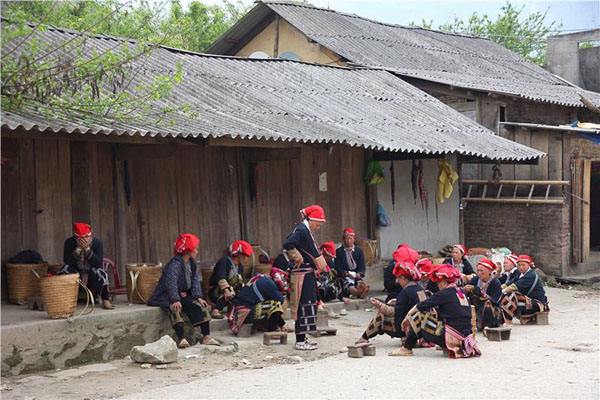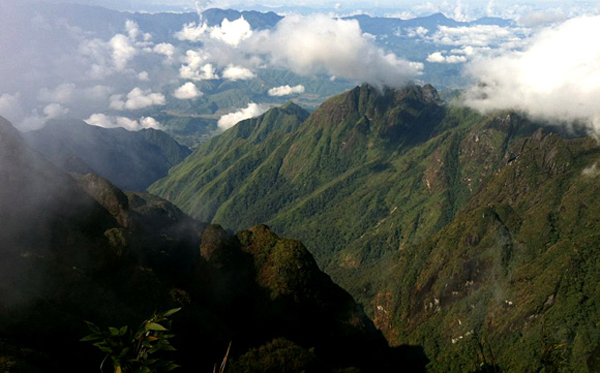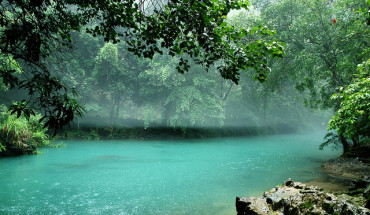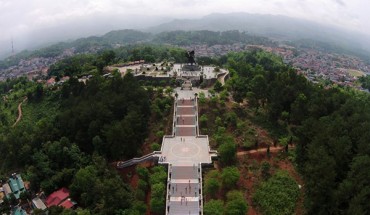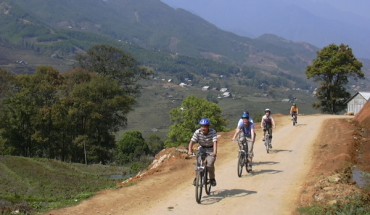Ham Rong Mountain Tourist Area
Ham Rong Mountain Tourist AreaLocation: Pho Ham Rong, Thi tran Sapa, Huyen Sapa, Lao Cai Opening hours: 7am-6pm daily Ham Rong or ‘Dragon’s Jaw’ Mountain, on which Sa Pa’s radio transmitter is situated, is located immediately above Sapa town centre and can be climbed by following the steps behind the Ham Rong Hotel. In recent years the Ham Rong Rubber Company, which runs the hotel at the foot of the hill, has turned the entire 148-hectare site into a tourism area – after paying the entrance fee at the bottom of the hill visitors can make their way through a series of attractions, including an orchid garden with around 6, 000 plants from 194 different orchid species, a European garden with flowers imported from France and Russia, a children’s playground, a ‘stone forest’ and a performance area featuring ethnic music and dance shows. The hill offers excellent views of the town and beyond it the Muong Hoa valley and Mount Phang Si Pan.
Cat Cat and Sin Chai Tourist Areas
Cat Cat and Sin Chai Tourist AreasNhung Khu Du lich Cat Cat va Sin Chai The road heading down the hill in a westerly direction out of Sapa town offers either a short 4-kilometre round trip walk to Cat Cat Black H’mong village or a longer 12-kilometre round-trip walk taking in Sin Chai Black H’mong village. A fee is payable before entering the valley. Both villages have designated houses where foreign visitors are allowed to stay overnight, however if you are not visiting as part of a pre-arranged tour you must first obtain a permit to stay overnight in an ethnic house from the Sapa Tourism Office (see below). Please note that the path descending from Sapa to Cat Cat is very steep, but on the return leg of the journey there are always plenty of xe om (motor bike) drivers on hand to ferry the exhausted or unfit back up the hill to their hotels.
Cat Cat Village
Location: Ban Cat Cat, Xa San Sa Ho, Huyen Sapa, Lao Cai
Heading through the checkpoint/ticket booth and down the hill, travellers will arrive 1 kilometer later at a path which descends steeply to the Cat Cat village tourist area. Souvenir stands line the route and half way down in a traditional crafts area managed by the Cat Cat Traditional Handicrafts Co-operative Society visitors can see a Black H’mong blacksmith at work, sample local cuisine and purchase traditional forest medicines, silver jewellery, stone sculptures and traditional leaf painting. Next to the picturesque ‘Cascade’ waterfall (from which the village takes its name) at the bottom of the hill are the buildings of the old French hydroelectric power station, which supplied electricity to the town from 1927 until the end of the colonial period. One of the power station buildings has recently been turned into a small theatre where performances of traditional H’mong and Dao music and dance are presented throughout the day . The path then continues around the valley just below the residential area of the village before ascending to the Sa Pa-Sin Chai road.
Sapa Market (Sunday)
Sapa Market (Sunday)Location: Cau May, Thi tran Sapa, Huyen Sapa, Lao Cai
While centered on the main market building, Sa Pa’s bustling Saturday market spills out over the surrounding streets, offering a colorful and highly photogenic gathering of all the major ethnic people to be seen in and around Sapa district – Black H’mong, Giay, Xa Pho and local groups of Red Dao are very much in the majority, but White H’mong and Flower H’mong visitors from other parts of Lao Cai Province are also in evidence.
Many guide books continue to mention a ‘Love Market’ (Cho ) where ethnic minority teenagers meet members of the opposite sex. Like other weekly markets throughout the North West, Sa Pa’s busy Saturday market is as much about socialising as it is about doing business, and to ethnic minority youngsters it has always been a place to meet friends. As recently as the late 1990s, the sound of traditional call-and-response H’mong courtship songs – albeit played on cassette players – could still be heard after dark throughout the town on most Saturday nights, but the advent of mass tourism – with over-zealous visitors taking intrusive photos – has since put paid to that tradition. If there is still a ‘Love Market’ in Sapa, it now takes place in secret locations in the dead of night, well away from the prying eyes of foreign tourists.
The Black H’mong (H’mong Den) of Sa Pa
The Black H’mong (H’mong Den) of Sa PaThe Qiandong (Central Hmongic)- speaking language Hmoob Dub/Hmong Dub or Black H’mong (H’mong Den) may be found exclusively in the Sapa region of Vietnam As their name would suggest, the Black H’mong costume of both sexes is predominantly black indigo batik skirt and shirt with embroidered rings on the sleeves characteristic of other branches of H’mong are usually only worn by young girls up to the age of puberty, at which point they are replaced by an above-the-knee plain black skirt with black leg warmers and a plain black jacket with a thin red or white border.
Along black waistcoat, generally made nowadays from glossy beaten hemp and bordered in white and/or red, is worn over the jacket and tied at the waist; below the waist it forms a front-and- back apron. The hair is tied in a bun and a black circular hat with a hole at its centre placed over it. Large heavy silver jewellery is also worn. Black H’mong male attire comprises a plain black shirt worn under a glossy black waistcoat, plain black pantaloons and a plain black skullcap.
The Red Dao (Dao Do) of Sa Pa
The Red Dao (Dao Do) of Sa PaCostume-wise, the Kiem Mien Red Dao (Dao Do) of Sapa District are one of the most spectacular branches of the Dao family, with a range of different costumes quite distinct from those of their Im Mien and Kim Mien cousins in other parts of Lao Cai Province. There are many local variations in their traditional clothing from village to village, but common features of those to be seen in and around Sapa include trousers embroidered with flower patterns or rectangular motifs worn over plain black leg-warmers, a loose- fitting black jacket with an embroidered collar and lower sleeves and an embroidered back-panel, large quantities of chunky jewellery and a scarlet scarf or turban.
Some Red Dao in this area wear a plain red scarf with a white border, occasionally hung with silver coins, whilst others wear a large red turban decorated with silver beads and hung with long led and yellow tassels, reminiscent of the plumage of exotic birds. Like their Sewing Dao cousins, the Red Dao women of Sapa District shave off their eyebrows and shave their hair back to the top of the head in order to display a larger area of forehead below the turban.
The Giay
The Giay (pronounced ‘Zay’) belong to the Austro- Asiatic language family and specifically to the Tay-Thai language group. They began to migrate south from southern China some 200 years ago, a process which continued until the middle of the last century. Today Giay settlement is concentrated in the Sapa and Bat Xat Districts of Lao Cai Province, although the Giay sub-ethnicities of Nhang and Pu Na may also be found outside of this region in the Phong Tho and Tam Duong Districts of Lai Chau Province and in the Dong Van and Yen Minh Districts of Ha Giang Province. There are currently 49, 098 Giay in Vietnam (1999 census), making them the country’s 25th largest ethnic minority grouping.
Giay people build their houses directly on the ground in the river valleys. Constructed entirely of wood, the typical Giay house comprises a central living area accessed through an indented porch in the centre of one long wall, at either side of which are located the sleeping and kitchen areas. Villages can contain up to 100 houses. Giay people generally grow wet rice, maize, sweet potato, manioc and fruit such as oranges, plums and peaches.
The Giay people are primarily ancestor- worshippers, but also preserve traditions relating to former animist beliefs, such as paying their respects to the spirit of the door or the hearth.
The Giay language would appear always to have been oral. Stories and legends of the Giay people are still told by members of the older generation, although such traditions are fast dying out.
Although weaving was once to be found widely amongst Giay communities, it is now rarely practised since most cloth can now be bought in cheaply from outside. Jewellery making has also died out, since Giay women now no longer wear earrings, bracelets or necklaces. However, embroidery, basket weaving and carpentry persist in many areas.
The Giay preserve many of their old folk songs, most of which are sung unaccompanied. Musical instruments used for special songs and dances include a bamboo flute, a reed oboe and a variety of small drums.
The traditional women’s costume in the Giay settlements of Lao Cai and Lai Chau Provinces consists of black trousers and a colored shirt (light or dark pink, light or dark blue, light or dark green, or white) decorated with a wide band of different-colored fabric which stretches around the collar and down to the clasp under the right armpit; older women generally wear a plain grey or black shirt. This ensemble is generally worn together with a patterned or plain headscarf. Giay men traditionally wear plain black trousers and tunic but nowadays this is increasingly being replaced by modern Vietnamese clothing.
The Xa Pho of Sa Pa
The Xa Pho of Sa PaSettled exclusively in the Sapa District, the Xa Pho are a sub-ethnicity of the Phu La, a Sino- Tibetan-speaking group found further east in the Bat Xat, Muong Khuong, Bac Ha and Si Ma Cai Districts of Lao Cai Province . The Xa Pho are renowned for the beauty of their traditional clothing, which is very different from that of their Phu La cousins. Xa Pho women wear calf-length dark indigo wrap-around skirts with both upper and lower decorative bands of dark red and white embroidery, along with matching shirts and a white waist band. A black or multi-colored turban and jewellery made of shells or colored beads are also generally worn.
The White H’mong (H’mong Trang) of Bat Xat
The small numbers of White H’mong (H’mong Trang) to be seen at weekends in Sapa hail mainly from the Bat Xat region to the north.
The Flower H’mong (H’mong Hoa) of eastern Lao Cai Province
The Flower H’mong (H’mong Hoa) of eastern Lao Cai ProvinceAlready seen in small numbers in and around Lai Chau, the Flower H’mong (H’mong Hoa) of eastern Lao Cai Province – found throughout a very large area embracing Bao Thang, Bao Yen, Bac Ha, Muong Khuong and Si Ma Cai Districts – wear very different costumes than their Flower H’mong cousins in Hoa Binh and Son La Provinces and are without doubt the most colorful of all of Vietnam’s ethnic minority groups. The women of this branch of Flower H’mong wear a highly-colorful calf-length embroidered indigo batik skirt together with a green, blue or black plain or patterned shirt richly decorated by a band of embroidered and sometimes tasseled material which leads around from the collar to the clasp under the right shoulder; panels of embroidery also adorn the lower sleeves. The outfit is usually worn together with a small embroidered front-and-back apron, embroidered leg-warmers, a plain or patterned scarf, silver jewellery and (at festival times) also a trimmed circular hat.
Sapa Museum
Location: Trung tam Thong tin Du lich Lao Cai, 2
Fansipan, Thi tran Sapa, Huyen Sapa, Lao Cai
Telephone-. 84 (0) 20 387 1975
Fax: 84 (0) 20 387 1976
E-mail: sapatourism@hn. vnn. vn
Opening hours: 7.30am-11.30am 1.30 pm-5.30pm,
7.30pm-10pm daily
Opened in 2007, this small museum is part of the Sapa Tourist Information Centre complex and contains various artifacts depicting the daily life of the ethnic minorities of Sapa District, plus costumes of the main ethnic groups.
Sapa Church
Sapa ChurchLocated right at Ham Rong street in the center of Sapa Town, Sapa District, Lao Cai
Originally constructed in 1934 and completely renovated in 2000-2004, the old French Parish Church which stands at the centre of the town is of relatively little architectural interest, but it does have an interesting story attached to it.
Murder at matins
During the devastating Viet Minh attack on Cha Pa in February 1947, most of its French buildings suffered serious damage, and although the town was subsequently reoccupied by French forces, thereafter only a handful of French civilians remained. One of these was Father Jean Idhiart- Alhor, last French Vicar of the Cha Pa Parish Church, which remarkably had survived the attack relatively unscathed. Despite the fact that all of his former French congregation had now gone, Father Jean decided to ignore official advice and remain in Cha Pa to look after his Vietnamese and ethnic minority flock – but this fateful decision would cost him his life.
At 7am one morning in around May 1948 – sources disagree on the date – members of his congregation arrived at the church to find Father Jean’s decapitated body lying next to the altar. Official French reports subsequently declared him the victim of a Viet Minh attack, but informed sources suggest that Father Jean was murdered because he had attempted to put an end to an amorous liaison between a male member of his congregation and one of the young novices who had remained at Ta Phin Convent to tend the farm following the departure of its nuns. Apparently, in an attempt to cool the relationship down, Father Jean had placed the young man under house arrest in the Villa Marguerite, next to Cha Pa Parish Church. However, this only served to antagonize him, and as soon as he was released he took swift revenge on Father Jean. In 2006 Father Paul Pham Van Binh became the first pastor of Sapa Parish to be appointed by the Roman Catholic Diocese of Hung Hoa since the death of Father Jean in 1948.
Sin Chai Village (Tourist Area)
Location: Ban Sin Chai, Xa San Sa Ho, Huyen Sapa, Lao Cai
Returning to the Sa Pa-Sin Chai road, Sin Chai village is located a further 4 kilometers to the west of Cat Cat village. It was to here that all the H’mong people living in the area now occupied by Sapa town were forcibly relocated when the French first arrived in Sapa in the early years of the 20th century. Today the village offers opportunities to visit Black H’mong houses and sample the local way of life.
Muong Hoa Valley
Muong Hoa ValleyThung lung Muong Hoa Location: Huyen Sapa, Lao Cai Most of Sa Pa’s trekking destinations may be reached by heading in a south westerly direction out of the town and down into the stunningly beautiful Muong Hoa Valley, heartland of the Hoang Lien National Park, a 30, 000-hectare reserve renowned for its tiered forest ecosystems where ethnic villages sit beneath beautifully sculpted rice terraces. The park contains over 2, 000 plant species and around 500 animal species, including the rare black gibbon.
Descending along the main road from Sapa, travelers may trek to a wide selection of ethnic villages in this area. Guided tours ranging from half a day to seven days in length are offered by all of the major travel agencies in Sapa (see below), visiting villages such as Lao Chai (Black H’mong), Ta Van (Giay), Seo My Ty (Black H’mong), Giang Ta Chai (Red Dao), Den (Tay) and further afield Ta Chung Ho (Red Dao), Su Pan (Black H’mong), Ho (Tay) and Nam Cang (Xa Pho).
Homestays are available in many villages, but those who are not visiting as part of a pre-arranged tour must first obtain a permit to stay overnight in an ethnic house from the Sapa Tourism Office and should take care only to stay in a house which is licensed by the local government. Please note that police make regular checks on villages in the valley and fines for contravening regulations can be steep.
In addition to superb scenery and ethnic minority villages, the Muong Hoa Valley also boasts an important heritage site, namely the Ancient Inscribed Stones of Sa Pa .
Ancient Inscribed Stones of Sa Pa
Located some 10 kilometers down the Muong Hoa valley to the south east of Sapa, these ancient inscribed stones lie on the westward side of the road, adjacent to a stream. Brought to international attention in 1925 by French archaeologist V Goloubew Roches, the site comprises around 100 engraved stones of various sizes, the largest measuring 3-4 meters high by 14-15 meters long and the smallest 1-2 meters high by 1-2 meters long. Scholars have identified six main types of engraving – parallel lines, squares and rectangles, circles, sketches of deep-roofed stilted houses, human figures and examples of ancient writing. Some believe that the carvings once indicated the demarcation of prehistoric tribes living in the area, with parallel lines depicting mountainous rice terraces and squares and rectangles representing plots of crop cultivation. The human figures may depict stories about legendary ancestors, with the linked couples representing symbols of fertility. Unfortunately there is insufficient evidence to link the ancient script found on many of the stones either with ancient Chinese or with any of the known scripts of ethnic minority groups who have settled this region.
An exhibition hall (Nha trung bay Khu cham khac da co Sa Pa) containing various displays relating to the history and likely meaning of the inscribed stones was opened at the site in 2003, though sadly these days it remains padlocked unless prior arrangements are made for someone to open the doors.
Ta Phin Tourist Area
Ta Phin Tourist AreaLocation: Xa Ta Phin, Huyen Sapa, Lao Cai To get to Ta Phin travellers should head north east out of Sapa along National Road 4D to Lao Cai. Six kilometres later a left hand fork immediately before
Bridge 32 (Cau 32) leads a further six kilometres along a track past the ruins of Ta Phin Convent before ascending into the Ta Phin (in ancient times Dai Binh or big plain) valley. A checkpoint/ticket office is located halfway along this road, close to the ruins of the Ta Phin Convent:
Ta Phin Convent
Location: Xa Ta Phin, Huyen Sapa, Lao Cai In January 1941 the French Ambassador in Japan requested the Bishop of Hung Hoa to welcome a group of nine Reformed Cistercian or Trappistine nuns who had been driven out of Japan. In the following month the Resident-Superior of Tonkin granted a long-term lease over the estate of the old fruit-growing station of Ta Phing, uncultivated or fallow land for the token rent of one piastre per annum.
The sisters arrived in June 1942 and were given eight milk cows, nine calves, two oxen, two heifers, one bull, 24 hens, six pigs and farming implements so that they could begin large-scale raising of pigs and chickens and usefully complement the dairy products, milk, butter and cheese produced by the Cha Pa station in sufficient quantity for the number of summer visitors both civil and military. They also ‘set about to grow black wheat, oats, barley, buckwheat, and to develop fruit trees, potatoes, vegetables and vineyards.
Construction of the convent building began immediately; the foundation stone of the Cistercian Convent of Our Lady of Peace was laid on 8 October 1942 and may still be seen today at the westernmost corner of the ruin. However, plans for a second main building to house a hundred sisters, lay sisters and novices, as well as guest quarters and a chaplaincy, came to nothing. Only the farm buildings, still partly visible, were ever constructed.
In September 1942 the sisters were producing peaches, apples and other fruit jams and had difficulties satisfying the numerous orders for butter and cheese of the Port Salut-type coming from Hanoi. In subsequent years the Cistercian Convent at Ta Phin became the main provider of dairy and other fresh products for the Cha Pa hill station.
Unfortunately the 1947 unrest forced the sisters to flee to Hanoi, and following their departure the convent was badly damaged by advancing Viet Minh forces. Nonetheless a few young novices remained at the site and continued to tend the farm, setting the scene for one of the more bizarre incidents in Sa Pas history.
Continuing on from the convent ruins, the track descends a further 3 or 4 kilometers past a number of small Black Hmong settlements into the Ta Phin valley, which is populated mainly by Red Dao people
In recent years Ta Phin has become a very popular tourist destination, and every vehicle carrying foreign tourists is now routinely mobbed on arrival by large groups of Red Dao women and children hawking their wares.
The main settlement of Sa Seng village was built upon a series of strange rock formations (once a sacred site for the ethnic people of the area). Here Red Dao women may be seen producing clothing and other items in a small workshop (Cau lac bo Phat trien Nghe det Tho cam) for sale by the Hanoi -based craft development NGO Craft link. Less than one kilometer from Sa Seng village on the opposite side of the valley is the Ta Phin Cave:
Ta Phin Cave
Location: Ban Sa Seng, Xa Ta Phin, Huyen Sapa, Lao Cai
Admission: Free of charge, local guides with torches may be hired
Ta Phin Cave comprises several separate caverns and features various stalactite formations.
Silver Waterfall Tourist Area
Location: Xa San Sa Ho, Huyen Sapa, Lao Cai
Opening hours: 7am-6pm daily
Situated 13 kilometres west of Sapa to the left of the National Road 4D as it enters Lao Cai Province from Lai Chau, the Silver Waterfall (Thac Bac) is around 100 metres tall. It is possible to climb half way up to a bridge which connects both banks, offering an excellent view of the waterfall and the mountains beyond, before returning down the other side.
Mount Fansipan
Mount FansipanLocation: Xa San Sa Ho, Huyen Sapa, Lao Cai Mount Phang Si Pan (elevation 3, 143 metres) may be reached only on foot from Sapa. Although it is located only 5 or 6 kilometres beyond Sin Chai village, the terrain on the approach to the mountain is difficult and the round trip takes a minimum of two days. Accommodation and food is available in a small village at around the 1, 500 metre mark and all those making the ascent stay in an overnight camp situated at around 2, 200 metres (3-4 hours from Sa Pa) before making the final ascent (4 hours) the next day. While no ropes or technical climbing skills are required, the area around Phang Si Pan is often cold, wet, slippery and dangerous, and those making the climb must be in very good shape. Please note that local government regulations currently require those wishing to climb Mount Phang Si Pan to obtain a permit and hire a local guide.
Things to buy in Sa Pa
The forests around Sapa are renowned for their abundant resources of natural medicinal plants, which are sold along with giant forest mushrooms in stalls around the town.
Sapa is also a great place to stock up with rice wine of every conceivable variety, including medicinal wine prepared with forest herbs.
Sapa Tourist Information Centre
Location: 2 Fansipan, Thi tran Sapa, Huyen Sapa, Lao Cai
Telephone: 84 (0) 20 387 1975
Fax: 84 (0) 20 387 1976
E-mail: sapatourism@hn. vnn. vn
Website: http://sapa-tourism.com
Opening hours. 7.30am-11. 30am, 1. 30pm-5. 30pm,
7. 30pm-10pm daily
Opened in 2007, this complex includes three buildings an Information Centre (and an office of Vietnam Airlines), a Traditional Music and Dance Hall and a Museum and Souvenir Shop. The Museum contains various artifacts depicting the daily life of the ethnic minorities of Sapa District, plus costumes of the main ethnic groups.
Extra reading about Sapa tours.


